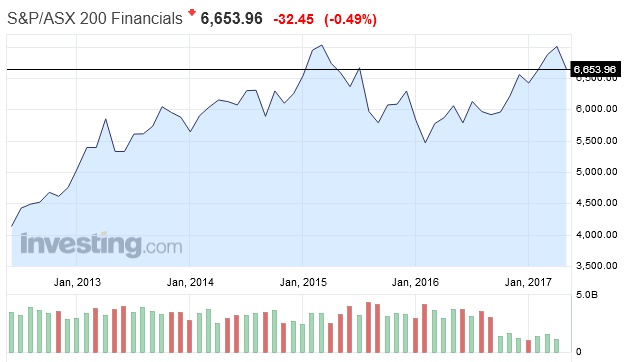The levy will certainly have consequences for bank pricing, forms of funding and competition – and will interact in complex ways with other prudential regulatory changes in the pipeline.
The levy will affect the four major banks and Macquarie. It will apply to liabilities other than deposits protected by the Financial Claims Scheme (ie. under A$250,000) and additional Tier 1 capital instruments.
As a ballpark estimate, it will apply to around 50% of a bank’s total funding, raising the overall cost of funding for the affected banks by around 0.03%.
The large banks are perceived to receive a competitive benefit (lower borrowing costs) from an implicit government guarantee associated with being “too big to fail”. On this basis, the levy could be seen as a charge for that benefit.
As it is in Europe, Australia could establish a “resolution fund” to enable the Australian Prudential Regulation Authority (APRA) to facilitate a smooth exit (ie by merger) of a failing bank. Although this levy is going to be set aside by the government for budget repair, rather than being set up in another separate fund, it could be argued that it strengthens the government to support APRA in regulating the banks.
The nature of the regulatory system (such as capital adequacy requirements) creates a competitive imbalance favouring the big four banks. The imposition of higher minimum capital requirements for mortgage loans by banks (five banks were actually subject to this levy) was only a partial response to this imbalance.
It’s often argued Australian banks have relied too much on funding, other than “core/stable” deposits and capital, with potential consequences for safety and systemic stability. Indeed, the large banks have funded their increased share of home mortgage lending since the global financial crisis to a significant degree from wholesale borrowings.
However there are better ways of dealing with these perceived distortions than the government’s quick, politically opportunistic, measure. And, together with other bank accountability measures introduced in the budget, it may neutralise whatever support exists for a Banking royal commission.
The levy is likely to have a number of significant effects on financial markets and consumers of financial services. The levy will flow through the banks’ funds transfer pricing systems to affect loan pricing.
In this regard it is somewhat silly to simultaneously suggest that the big banks shouldn’t increase loan interest rates, as the Treasurer has, but that the measure will improve the competitive position of smaller banks. The latter will only happen if the large banks do respond in that way!
The large banks will have incentives to fund loans differently. In particular, by originating and then securitising loans (pooling various types of contractual debt, to get them off-balance sheet and funded by the capital market) they will avoid the levy on that part of their activities.
However, that benefit won’t apply if they use “covered bond” securitisation. This is when debt securities are issued by a bank and collateralised against a pool of assets, giving the investor a claim against both those assets and the bank in general. The levy is thus likely to give a kick to traditional securitisation over on-balance-sheet lending, but stymie the growth of covered bond funding.
The levy will also affect the structure of bank deposit interest rates. Because retail deposits are exempt from the levy, the large banks can be expected to bid for these deposits – pushing up the interest rates offered relative to the cost of borrowing in wholesale and large deposit markets.
That’s going to compound the already apparent effect on relative interest rates due to recent and forthcoming liquidity regulations being applied by APRA. But it will worsen the relative returns that superannuation funds can get on (their large) bank deposits and possibly induce them to look towards investing more in securitised products.
It’s also worth noting that the budget involves changes which will increase competition for retail deposits. One example is the measure allowing individuals to make limited, tax advantaged, contributions to superannuation which can be subsequently withdrawn for a house deposit.
A further likely effect is to encourage banks to make more use of equity capital and additional Tier 1 (AT1) capital funding (that preferences share structures listed on the ASX and held by many retail investors), relative to Tier 2 capital funding (provided by the wholesale and institutional markets), or other wholesale funding. While more capital funding is still required to meet the “unquestionably strong” criteria proposed by the Murray inquiry, and accepted by the government, it’s far from clear that increased reliance on the complex AT1 is a desirable outcome.
The revenue to be raised is large in absolute dollar amount – but is relatively small as a percentage of current bank profits (in the order of 4-5%).
It could be expected that some part of the levy will be passed on to customers, or avoided by the banks shifting to other forms of funding which do not incur the levy, such that the short run direct impact on after tax profits and shareholders is somewhat less than that 4-5% figure.
But the big unknown is how the change, in conjunction with a plethora of other ongoing regulatory changes affecting the financial sector, affects the competitive balance between the big banks, smaller bank competitors and capital markets and their prospects in the long run.
Author: Kevin Davis, Research Director of Australian Centre for FInancial Studies and Professor of Finance at Melbourne and Monash Universities, Australian Centre for Financial Studies
 The Treasurer confirmed this is a permanent change to the landscape, and linked it to competitive disadvantage smaller players have relative to the majors, thanks to the implicit government guarantee. He also underscored the excessive profitability of these banks relative to other markets, which speaks to the structural issues we have here.
The Treasurer confirmed this is a permanent change to the landscape, and linked it to competitive disadvantage smaller players have relative to the majors, thanks to the implicit government guarantee. He also underscored the excessive profitability of these banks relative to other markets, which speaks to the structural issues we have here.

